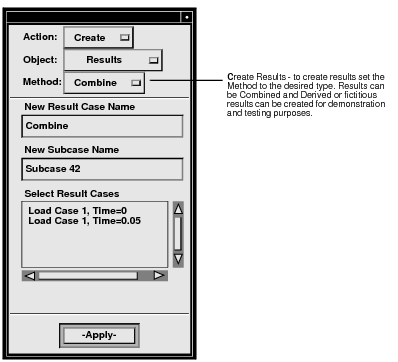For an overview of how the Results Application works please see
Introduction to Results Postprocessing, 1. Results can be derived, combined or created in a variety of ways.

Combined Results: This Method allows for the scaling and combining of selected Result Cases. This is most commonly used for linear superposition of subcases. Although most analysis codes feature subcase superposition, this operation can also be done in Patran while the analysis code solves for only the individual subcases. Combining results using this method is limited to scaling each selected Result Case and then adding together the individually selected Results Cases to create a new Result Case and subcase. Common results quantities must be selected for the combination and each Result Case must be associated with the same finite element entities. A detailed explanation of this Method is described in
Combined Results, 4.
Derived Results: This Method can be set to Maximum, Minimum, Sum, Average, and PCL Function to allow for derivation of results quantities in a variety of different manners. New results may be derived from maximum/minimum values from selected Result Cases and/or layer positions or results may be used in a PCL expression to derive a new result quantity. Derived results differ from combined results in two ways: (1) results to be derived may belong to different sets of nodes or elements which may or may not be disjointed whereas results to be combined must belong to exactly the same entities; and, (2) derived results are computed by varying procedures whereas combined results are computed by linear combinations (sum of scaled values). A detailed explanation of these Methods are described in
Derived Results, 7.
Demo Results: This capability is more meant for simple creation of results for demonstration and testing purposes when no results are available. See
Demo Results, 16.

